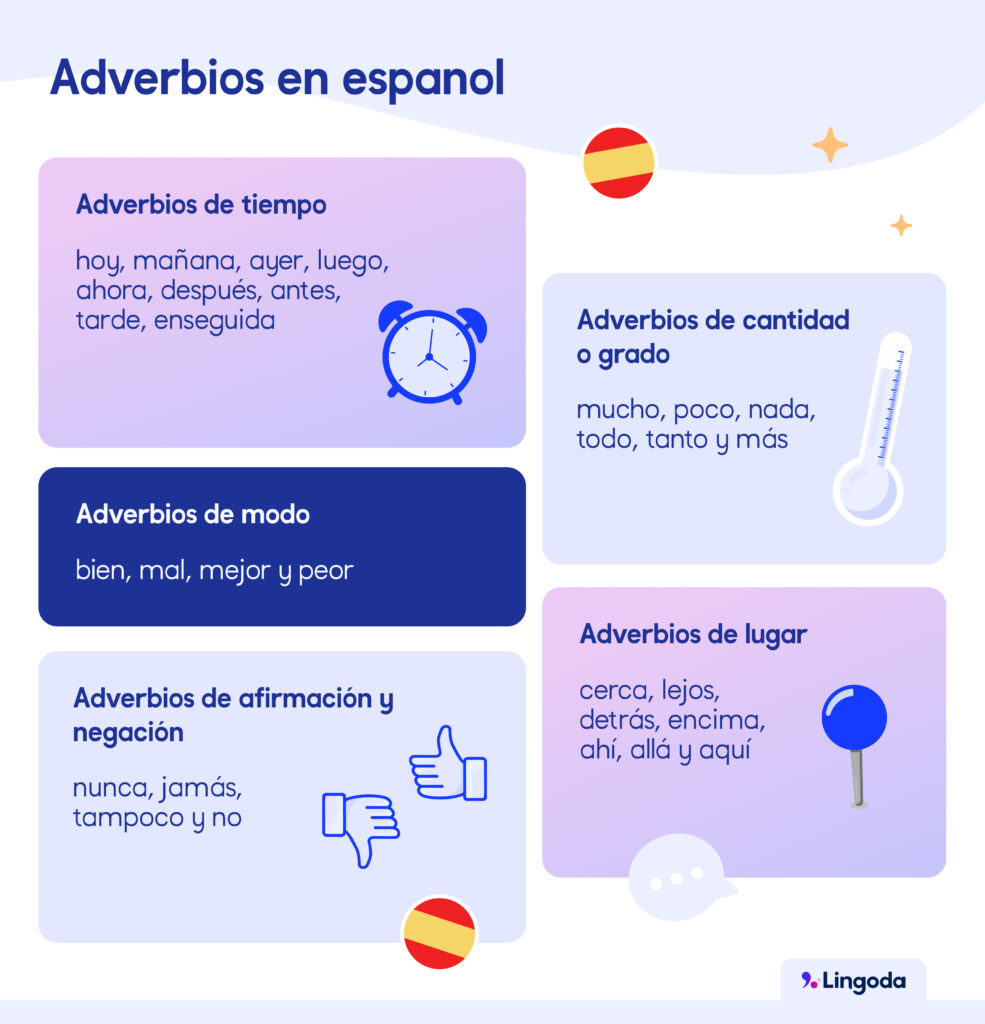The most common Spanish adverbs and how to use them

Whether you’re learning Spanish for work or pleasure, knowing some of the most common Spanish adverbs will be a super useful addition to your toolbox. You’ll be able, for example, to tell stories or describe situations in detail and speak Spanish more naturally. So, stick around as we dive into all things adverbs –what they are, how to use them, how to form them and some examples. Let’s go!
- What are Spanish adverbs?
- How to form adverbs in Spanish
- Types of Spanish adverbs
- Spanish verbs that function as adverbs in English
- Where to place Spanish adverbs
- FAQs
What are Spanish adverbs?
First things first: What are Spanish adverbs and what are they good for? Adverbs modify or complement verbs, adjectives, other adverbs or entire clauses. They give us information about the time, place, intensity or manner in which an action is occurring, has occurred or will occur. In short, they provide context and help us describe actions more clearly.
Adverbs often answer questions like how, when, how often or where something happened or is happening. Some examples include: mañana (tomorrow), ahora (now), rápidamente (quickly), and bien (well).
Here are a couple of sentences using adverbs:
- Mañana nos vamos de viaje (we’re traveling tomorrow).
- Cambié el canal rápidamente (I changed the channel quickly).
Adverbs vs. Adjectives
A common mistake when learning Spanish is confusing adverbs and adjectives, since both are used to describe something. However, they have different purposes.
Adjectives describe nouns or pronouns (people, objects, etc.), while adverbs modify verbs, adjectives, adverbs or clauses.
For example:
- Adjective: Ella es rápida (she is fast).
- Adverb: Ella corre rápidamente (she runs fast/quickly).
As you can see, the adjective modifies the subject (ella or ‘she’), while the adverb describes an action (correr or ‘to run’).

Learn Spanish with Lingoda
How it works

How to form adverbs in Spanish
Now we know what Spanish adverbs are. But how do we form them? Here are some ways to do it:
- Transforming adjectives (regular adverbs): One of the most common ways to form an adverb is to take an adjective and transform it. In fact, most adverbs are formed this way. They are what we call ‘regular’. To do this, we:
- Take the female form of the adjective (for example: rápida).
- We add the ending -mente, which is equivalent to ‘-ly’ in English (rápida-mente or 'quick-ly').
Note: Some adjectives have irregular forms (not ending in -mente) when turned into adverbs, such as: bueno (good), which becomes bien (well); malo (bad), which becomes mal (something done incorrectly); and grande (big), which turns into mucho (a lot).
- Combining two or more words: These can combine prepositions, nouns or other adverbs. For example: con frecuencia (with + frequence).
Aside from most adverbs ending in -mente, another key characteristic that will help us identify Spanish adverbs is that they are invariable. This means that, unlike adjectives or verbs, they don’t need to be conjugated or match gender or number (they always stay the same).
Types of Spanish adverbs
Spanish adverbs can be classified according to the kind of information they add to a sentence.
Here’s a list of some of the most common Spanish adverbs by type, along with examples of usage:

Adverbs of manner (Adverbios de modo)
These describe the way an action is being performed –they answer the question ‘how?’. Let’s have a look:
| Spanish | English |
| amablemente | kindly |
| así | that way |
| bien | well |
| bonito | pretty/nicely |
| despacio | slow |
| difícilmente | hardly |
| fácilmente | easily |
| lentamente | slowly |
| mal | incorrectly |
| mejor | better |
| normalmente | normally |
| peor | worse |
| rápidamente | quickly |
| rápido | quick |
| sinceramente | sincerely |
| tranquilamente | in a relaxed way |
Sentence examples:
- Se lo pregunté amablemente (I asked him kindly).
- Cantas bonito (you sing nicely).
- Mi pay está mejor que el tuyo (my pie is better than yours).
Adverbs of time (Adverbios de tiempo)
They provide information regarding the time, duration or frequency of an action –they respond to ‘when?’:
| Spanish | English |
| a veces | sometimes |
| ahora | now |
| anoche | last night |
| antes | before |
| ayer | yesterday |
| con frecuencia/ frecuentemente | frequently |
| después | after |
| hoy | today |
| luego | later |
| mañana | tomorrow |
| mientras | meanwhile |
| nunca/jamás | never |
| pronto | soon |
| raramente | rarely |
| seguido | often |
| siempre | always |
| tarde | later |
| temprano | early |
| todavía | still/yet |
Examples:
- Siempre me despierto a las 7:00 (I always wake up at 7:00).
- Corro seguido (I run often).
- Todavía te quiero (I still love you).
Adverbs of place (Adverbios de lugar)
These relate to the location where an action occurs, where it originated or where it’s destined:
| Spanish | English |
| abajo | below |
| acá | here |
| adentro | inside |
| afuera | outside |
| al lado | next to |
| ahí | there |
| allá | there |
| allí | there |
| alrededor | around |
| aquí | here |
| arriba | above |
| cerca | near |
| debajo | below |
| delante | in front/before |
| detrás | behind |
| encima | on (top of) |
| en medio | in the middle |
| enfrente | in front |
| lejos | far |
Examples:
- El vaso está encima de la mesa (the glass is on the table).
- Lo puedes poner ahí (you can put it there).
- Estoy sentada adentro del salón, frente al pizarrón (I’m sitting inside the classroom, in front of the blackboard).
Adverbs of quantity or degree (Adverbios de cantidad o grado)
These help us describe the intensity, amount or degree at which something happens –they answer the question ‘how much?’:
| Spanish | English |
| algo | some |
| bastante | quite |
| casi | almost |
| completamente | completely |
| demasiado | too much |
| extremadamente | extremely |
| más | more |
| menos | less |
| mucho | much |
| muy | very |
| nada | nothing |
| poco | little |
| solamente | only |
| suficiente | enough |
| tan | so |
| tanto | so much |
Examples:
- Me serví demasiado vino (I poured myself too much wine).
- Solamente quiero una rebanada (I only want one slice).
- Estaba bastante enojado (he was quite angry).
Note: These adverbs can also ‘intensify’ adjectives. For example: La casa de Lisa es muy grande (Lisa’s house is very big).
Adverbs of affirmation (Adverbios afirmativos)
We use these to reinforce an idea or express certainty:
| Spanish | English |
| ciertamente | certainly |
| claramente | clearly |
| efectivamente | indeed |
| evidentemente | evidently |
| exactamente | exactly |
| indudablemente | undoubtedly |
| obviamente | obviously |
| seguramente | surely |
| sí | yes |
| también | also |
| totalmente | totally |
Examples:
- Efectivamente, no sacó al perro a pasear (indeed, he didn’t walk the dog).
- Sí, voy a ir a la fiesta (yes, I will go to the party).
- Obviamente dije que no (I obviously said no).
Adverbs of negation (Adverbios negativos)
They deny or reject an action or express disagreement:
| Spanish | English |
| en absoluto | at all |
| nada | nothing |
| no | no |
| nunca/jamás | never |
| tampoco | neither |
Examples:
- Yo tampoco quiero pizza (I don’t want pizza either).
- No me gusta ese vestido en absoluto (I don’t like that dress at all).
Adverbs of doubt (Adverbios de duda)
These adverbs express uncertainty or doubt about an action:
| Spanish | English |
| a lo mejor | maybe |
| acaso | maybe |
| posiblemente | possibly |
| probablemente | probably |
| puede que | could/may be |
| quizá | maybe |
| tal vez | maybe |
Examples:
- Probablemente cocine lasagna (I’ll probably cook lasagna).
- Puede que repruebe el semestre (I may fail the semester).
Adverbs of question and exclamation (Adverbios interrogativos y exclamativos)
We use this to introduce questions or make exclamations. They’re placed at the very beginning, always carry an accent mark and may or may not be accompanied by ¡! or ¿?:
| Spanish | English |
| a dónde | where |
| cómo | how |
| cuándo | when |
| cuánto | how/how much |
| dónde | where |
| por qué | why |
| qué | how |
Examples:
- Cuánto te extraño (How I miss you).
- ¿Qué harás mañana? (What are you doing tomorrow?).
- ¿Dónde estás? (Where are you?).
Relative adverbs (Adverbios relativos)
These help us introduce subordinate clauses and are similar to question and exclamation adverbs, but they don’t hold the accent mark. They can relate to time, manner or place, and provide circumstantial context to the verb:
| Spanish | English |
| como | how |
| cuando | when |
| cuanto | how/how much |
| donde | where |
Examples:
- En donde vivo llueve mucho (it rains a lot where I live).
- Me avisas cuando vayas a la tienda (let me know when you go to the store).
Spanish verbs that function as adverbs in English
It’s worth noting that some verbs in Spanish translate as adverbs in English. This happens because, in Spanish, it can sometimes be easier to express the way something is happening by using two verbs instead of an adverb + a verb.
Here are two examples:
- Acabo de llamar (I just called) – Here, acabo comes from the verb acabar (to finish doing something) and it accompanies the verb llamar (to call).
- Sigo escribiendo (I’m still writing) – This comes from seguir (to still be doing something) and escribir (to write).
Where to place Spanish adverbs
Now, let’s talk about where to place adverbs in a Spanish sentence. Generally, Spanish adverbs go:
- After the verb (corro lento - I run slowly), which is similar to English. However, we may also see them before the verb (siempre bailo - I always dance).
- Before the adjective (el gato es muy bonito - the cat is very pretty), which is similar to English.
- Before another adverb (ella corre demasiado rápido - she runs too fast), which is also similar to English.
- At the beginning of the sentence if they’re intended to emphasize a clause (efectivamente, no fui - indeed, I didn’t go). This is similar to English as well.

Learn Spanish with Lingoda
How it works

What are the regular adverbs in Spanish?
Regular adverbs in Spanish typically end in -mente. For example: obviamente, frecuentemente, perfectamente and rápidamente. For their part, irregular adverbs are those that don’t follow this rule, such as: bien, mal, a veces, seguido and tal vez.
How do you turn words into adverbs in Spanish?
The easiest way to do this is to take the female form of an adjective and add the suffix -mente. Example: perfecta (perfect) turns into perfectamente (perfectly).
What is an adverb example in Spanish?
Here are a few example sentences using adverbs in Spanish:
- Yo nunca cocino (I never cook) – adverb of time/negation
- ¡Camina despacio! (Walk slowly!) - adverb of manner
- Posiblemente me mude de país (maybe I’ll move countries) – adverb of doubt
Practicing… seriously
Learning the most common Spanish adverbs will help us express ourselves with more precision. For example, we’ll be able to describe the way in which something happened, how often we do sports or where our favorite restaurant is.
Now, if we’re looking to get some serious practice, there’s nothing like learning from a professional. At Lingoda, you’ll learn all about adverbs with native-level teachers who will have you speaking real-life Spanish from day one. Plus, you can choose your schedule and decide whether you want private or (small!) group classes. ¡Aprenderás rápidamente!
















